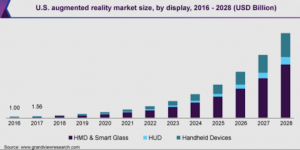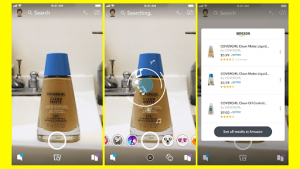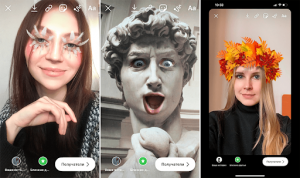It is an accomplished fact that currently, social networks are an integral part of many people’s daily lives. In addition to regular correspondence, users communicate via video calls, check out the latest news, and even start their own business, as well as advertise it through social networks. No wonder some people call them a universe of its own that is constantly evolving and progressing. AR technologies facilitate this process.
Competition forces companies to continuously improve the performance and capabilities of their platforms. It’s impossible to surprise anyone with a convenient and feature-rich app nowadays. The introduction of augmented reality technologies has become a new trend in the effort to expand the consumer audience.
Analysts of big brands have been extensively exploring the impact of AR on the development of social networks. Now let us examine how the further progress of these technologies can affect the companies themselves and whether augmented reality is actually the future of social networks.
What AR technologies are about
It is easy to be confused and think that augmented reality (AR) and virtual reality (VR) are the same technology. However, they are not.
VR is an artificial world being drawn from scratch in its entirety. It can be a simulation of another planet, a world from the past, or a fantasy depiction of the world in the future.
AR does not build a new world from scratch. Instead, it projects additional elements or effects onto the existing reality.
A simple comparison will help to perceive the difference in these technologies. Let us take any computer game as an example of virtual reality. It can be Dota, CS;GO, or even GTA. Here, the user is immersed in a fictional world and observes its simulation. However, the Pokemon Go game that generated a lot of buzz in 2016 is a spectacular example of augmented reality where 3D models of pokémon fit into the real environment.
Since then, the popularity of AR technology has been growing rapidly. So, as of 2020, the value of the global market for augmented reality was already estimated at $17.67 billion. For comparison, in 2016, this figure was about 20 times lower and did not reach even one billion dollars.

When it comes to the use of augmented reality, the leaders are such companies as:
- Microsoft;
- Google;
- Apple;
- Sony;
- Blippar.
An additional trigger for the market was the worldwide pandemic, as well as the availability and simplicity of devices that support augmented reality technology. AR has been increasingly introduced into social media.
In 2021, despite the forecasted increase of around 37%, the AR and VR market had actual growth of 92.1%. And as of now, everything indicates that the growth in AR popularity in 2022 will also exceed all expectations.
3 Immersive AR Use Cases in Social Media
When it comes to the use of augmented reality, the most familiar examples are major social networking platforms, such as
- Snapchat;
- Instagram;
- Tiktok.
Using augmented reality on Snapchat
Snapchat today heavily depends on augmented reality technology. The possibility to share photos with superimposed AR filters is considered a special feature of this company’s application. This is largely what the popularity of this service is based on. According to the company’s statements, active users interact with the proposed augmented reality features about 30 times a day.
Such a feature as the product search through scanning an item with the smartphone’s camera is one example of how AR technology is used in Snapchat. This platform was launched in 2018 and is primarily focused on the Amazon online store.

AR in Instagram
Not every user understands that popular Instagram masks are a tool of augmented reality. The filters enable you to apply makeup, correct skin tone, apply different effects, or even add new details or objects to the picture.

It is possible to use masks for simple photos as well as for videos and live broadcasts. You have to understand that half a billion people a day view stories on Instagram. This opens up great opportunities for branded AR filters.
Augmented reality on Facebook
Facebook also actively promotes augmented reality technology. The messenger even features games with AR. For example, Don’t Smile, where the first person to laugh loses, or Asteroids Attack where moving around the spaceship is controlled by scanning the player’s face.
Facebook also uses 3D filters and software to help with promotions. For example, one ad enables users to see the actual size of a purse offered in the online store.
AR communication: key trends
Despite the fact that the first virtual reality helmet was invented back in 1967, contemporary AR technology is relatively new. The development in this field advances at a great pace. This trend can be easily observed in digital communications.
New applications appear every day. They provide innovative possibilities for using augmented reality in communication. Let us tell you about the main trends in 2022.
Trend No.1: Promoting New Content
More and more 3D content is coming to replace 2D in social media. This trend greatly affects social networks and shapes the course of their further development. The use of interactive 3D content takes users into a completely new world. It not only adds new emotions but also brings practical benefits.
Trend No. 2: Attending Various Events from the Comfort of Your Home
With the help of augmented reality technologies, companies have the potential to reach a new level of interaction with customers. Now it is possible to arrange an interactive exhibition or another event in 3D. At the same time, visitors can get the feeling of actually being at the presentation and even interacting with sales assistants while staying in the comfort of their homes.
Trend No. 3: Virtual Museums with Augmented Reality Effects
Augmented reality technologies help arrange virtual exhibitions in museums. For this purpose, 3D models, animations, and videos of historical events or characters are used. For example, TRICKEYE Museum in Seoul offers such an exhibition.
And one of London’s museums used AR technology to organize an exhibition of Rembrandt’s paintings that had been stolen. There were empty frames hanging in the room. However, visitors were provided with a link to a downloadable app at the entrance. Having installed it, they could simply point their cameras at the frame to admire the displayed painting. It is worth mentioning that the paintings offered at the exhibition have still not been found. Nevertheless, visitors to the museum have an opportunity to see the works of famous artists with the help of augmented reality.
Trend No. 4: Virtual Fitting Encourages Social Media Shopping
Fashion shows of some apparel brands or beauty brands became available through the use of augmented reality technology. As a result, the publicity of the presentations has been greatly expanded, which means that the user audience has also been increased.
AR enables visitors to experience some of the products right from home. For example, by taking advantage of a virtual fitting, the potential customers understand whether the product offered suits them or not.
A striking example is the Estee Lauder beauty brand. Through the use of augmented reality technology, the brand has managed to expand the customer pool. According to the company, online sales increased by 60% even during the pandemic.
To understand the impact of augmented reality on social media shopping, just try to remember at least one apparel commercial you’ve seen lately. And now imagine that you were able to try on the item seen in that commercial and personally check its visual qualities with the help of AR. It is clear that the latter option is more interesting to the consumers and encourages them to make a purchase.
Banuba AR SDKs
Banuba is one of the leading companies in the field of augmented reality software development. Other developers have similar applications as well. Facebook or Snapchat use similar filters in their apps. However, Banuba AR technologies are more sophisticated from a technical point of view and provide more opportunities.
The main feature of the company’s products is the use of tracking technology. The application tracks the movement of almost any object simultaneously both in the foreground and in the background.
The Banuba AR SDK platform and its improved algorithms have greatly improved the quality of 3D masks. Applications based on this software can build an accurate model of the scanned surface, as well as recognize expressions, and faces, and read facial movements and emotions.
The platform is used for applications to be used in various industries, be it a company selling beauty products online or just an addictive game.
An example of an application in the entertainment sector is the Clash of Streamers game. Each player here can become his or her own character. For this purpose, the faces of the players are superimposed on their gaming characters. And all of the above can be achieved with Banuba AR SDK.
However, this is not the only successful product of the company. Such technologies as Banuba Video Editor SDK and Banuba Video Editor API are actively used for making video clips or even developing applications.
Conclusion
Given the current trends in AR development and its application in various industries, there is no doubt that even the future of social media is entirely dependent on these technologies. Increasingly, augmented reality is used by users and finds its audience.
However, developers do not stop at the results achieved and continue to improve AR. Huge efforts in this direction are being made by Banuba. And the technology itself is evolving at an accelerated pace, which will undoubtedly lead to a revolutionary new level of communication in social networks.
Related Posts
You may also like
-
Reformas Integrales en Sant Pol de Mar: Tu Proyecto con Éxito
-
Christmas Decorations for Businesses – Why Custom Baubles Are Worth the Investment
-
Cómo Elegir al Mejor Abogado para tu Caso
-
Improving Digital Presence with High Speed Singapore Business Broadband
-
Tips To Choose Between .com and .one Domain

